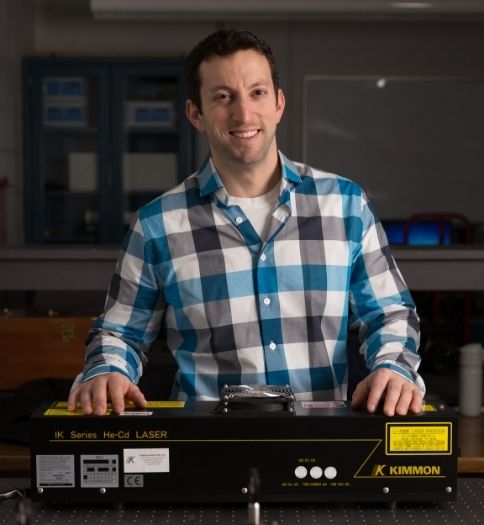Physicist Brandon Mitchell Unlocks Color Tunability in LEDs With an Eye on Quantum Information
NSF Funds His Research with $450,000 Grant
 The promise of incredibly high resolution even on small mobile devices is closer to
market thanks to a team led by Brandon Mitchell, West Chester Univeristy assistant
professor of physics. He has been awarded an approximately $450,000 National Science
Foundation (NSF) grant to explore new materials not only for efficient next-generation
displays but also for quantum computing.
The promise of incredibly high resolution even on small mobile devices is closer to
market thanks to a team led by Brandon Mitchell, West Chester Univeristy assistant
professor of physics. He has been awarded an approximately $450,000 National Science
Foundation (NSF) grant to explore new materials not only for efficient next-generation
displays but also for quantum computing.
In 2019, Mitchell led the international team that developed a technique making it possible to tune between bright white and more comfortable “warmer” colors in commercial LEDs (light-emitting diodes). He was the lead author with collaborators at Lehigh University, the University of Amsterdam, and Osaka University in Japan.
The resulting LEDs are capable of producing multiple colors individually with good efficiency, exhibiting low brightness, stability, and long life. This success can translate into more micro-display options from these LEDs and more sophisticated applications beyond monochromatic LEDs and lasing mediums.
With today’s technology, it takes three LEDs (red, green, and blue) to generate each pixel in a TV or computer monitor. Mitchell has found that, “The rare earth element Europium may let us grow all the colors on a single wafer.” He says some of the benefits of Gallium Nitride are “a simpler fabrication process that requires less energy and fewer steps.
For his current NSF-funded research, Mitchell will be collaborating with scientists at Lehigh and Osaka universities plus leaders in quantum information at the University of Pennsylvania. They will delve deeper into understanding the processes that occur within these LEDs, potentially opening the door to new non-consumer uses for these devices, such as applications in high-speed networking and data storage.
“For quantum information applications, most researchers put the rare earth ions inside insulators, which don’t conduct electricity. We’re the first to attempt this on semiconductors, namely Gallium Nitride and Gallium Arsenide.” Moreover, Mitchell and his colleagues will attempt to control individual atoms, which he says is “the higher risk/higher reward part of the project.”
And there’s a bonus for WCU undergraduates as well as graduate students at Lehigh and Penn since Mitchell is also principal investigator on a nearly $1 million NSF grant for WCU’s Scholarships in STEM (science, technology, engineering, and mathematics) Program (S-STEM). The $999,644 grant, awarded early in 2021, aims to increase enrollment and retention of low socioeconomic STEM students by creating a sustainable program in which experienced STEM students mentor newer majors in the STEM fields.
A total of $706,800 will go directly to the 18 talented STEM scholars, who are engaged in Nanoscience in Health and Technology. Two cohorts of nine students work together as an “accountability team” or learning community where participants depend upon each other for engagement and development and are mentored by faculty connected with WCU’s Center for Nanomaterials. As upper-level students, they will mentor newcomers to these majors and some will have the opportunity to be mentored by graduate students from Penn and Lehigh as part of Mitchell’s other research projects.
Mitchell reports that, over their three-week in-person pre-college STEMersion Camp last summer, the first nine students “became a community.”
This mentoring model not only ensures that Mitchell’s lab will be populated with a large, diverse, highly trained team of undergraduate students but that these students will be prepared for the work force or graduate school with experience in microanalysis and imaging science unusual for undergraduates to possess.
